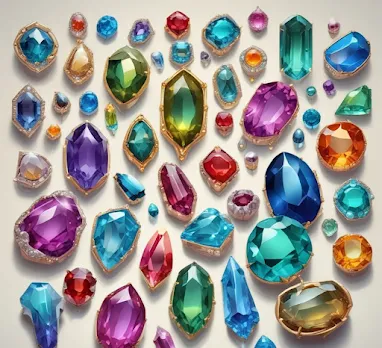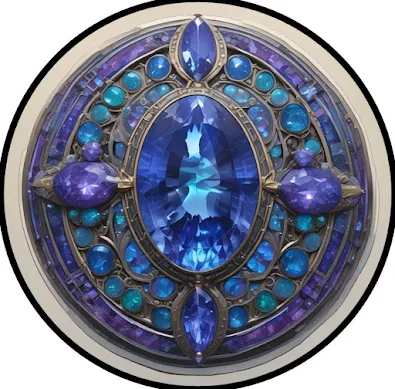Three Luxurious Rarity of the World's Most Exclusive Gems: Tanzanite, Alexandrite, and Black Opal
Variety of Gemstones - magicstudios
Tanzanite, Alexandrite and Black Opal
Gemstones captivate us not only with their stunning beauty but also with
their fascinating rarity and cultural significance. Among the most enchanting
treasures of the natural world are Tanzanite, Alexandrite, and Black
Opal, each offering a unique trait that sets it apart. They tell
stories of rarity, beauty, and cultural heritage.
As you delve into these extraordinary stones, think about which one aligns
with your personality or story. Would you choose the regal and rare Tanzanite,
the enchanting Alexandrite, or the mysterious Black Opal to reflect your
individuality?
Tanzanite was discovered only in 1967. Tanzanite is found
exclusively in a small area near Mount Kilimanjaro in Tanzania in East Africa,
making it about a thousand times rarer than diamonds. It is one of the most
captivating gemstones. Its scarcity is amplified by its geological exclusivity
and finite deposits. Experts predict the mines could be depleted within a few
decades, further enhancing its allure as a symbol of rarity and value. This gemstone
has gained immense popularity for its exclusivity and mesmerising hues. Its
pleochroism is a property that reveals stunning blue, violet, and burgundy hues
depending on the angle of light. These breathtaking colours have made Tanzanite
a favourite for statement jewellery, often symbolising individuality and
tivity. In its raw form, Tanzanite typically exhibits shades of brown, but
after heat treatment, it reveals its signature blue-violet hues. The deeper and
more vibrant the colour, the more valuable the stone. This duality of colour
has made Tanzanite a sought-after choice for jewellery, especially in statement
pieces such as necklaces and cocktail rings. Culturally, Tanzanite has been
embraced as a symbol of transformation and individuality. As it transitions
from a dull, raw state to a vibrant gemstone, it mirrors personal growth and
evolution, making it a meaningful choice for those seeking unique and personal
jewellery.
Would you choose a Tanzanite engagement ring over a diamond for its
rarity and vibrant beauty? Why or why not?
Variety of Gemstones - magicstudios
Alexandrite is renowned for its remarkable colour-changing ability. Alexandrite’s scarcity is attributed to the very specific geological conditions required for its formation, which include the presence of beryllium, chromium, and vanadium in just the right proportions. What makes Alexandrite truly magical is its remarkable colour-changing property. In daylight, it radiates a lush green, similar to an emerald. Under incandescent light, it transforms into a rich, purplish-red, making it a "gem of the day and night." This phenomenon is due to its complex crystal structure, which absorbs light differently depending on the source. High-quality Alexandrite with a pronounced colour change is incredibly rare and commands premium prices in the gemstone market. It was discovered in the Ural Mountains of Russia in the 1830s and named after Tsar Alexander II and is steeped in Russian imperial history. Its vibrant green hue resembled the colours of the Russian imperial military. Its colour-changing magic symbolises adaptability and balance, making it a cherished choice in fine jewelry. Beyond its beauty, Alexandrite has deep cultural significance. It is often associated with balance and adaptability, reflecting its dual colors. In metaphysical circles, it is believed to enhance intuition and creativity while also symbolising prosperity and good fortune. Alexandrite has also found a place in high-end jewellery, often serving as the centrepiece in bespoke designs.
If you could own a gemstone with magical properties, would you choose
Alexandrite for its dual colours and imperial history? What would you pair it
with in a piece of jewellery?
Black Opals are also called the fiery gems of lightning ridge. Black Opals are among the rarest and most valuable opals. They are found in Lightning Ridge in Australia, a small mining town that has become synonymous with these fiery gems. Their deep, dark body colour acts as a canvas for an explosion of iridescent colours, from fiery reds to electric blues; this phenomenon is called "play-of-colour." The play-of-colour in Black Opals is caused by the diffraction of light through their microscopic silica spheres. The arrangement and size of these spheres determine the colours and patterns seen in the gem. Some Black Opals feature a "harlequin" pattern—a grid of bright, block-like colours—that is especially prized among collectors. This striking visual effect has inspired artists and jewellers worldwide. In Aboriginal Australian culture, Black Opals are believed to be the embodiment of the rainbow, bringing good fortune and creativity to their bearer. Black opals differ from other opals because of their dark body tone, which enhances the vibrant play of colour on their surface. This dazzling display includes flashes of red, blue, green, and orange, creating a visual spectacle that has captivated gem enthusiasts for centuries. The discovery of Black Opals dates back to the late 19th century, though their popularity soared in the 20th century as mining operations expanded.
Culturally, Black Opals have long been associated with mystery and
creativity. In Aboriginal Australian lore, they are said to be the embodiment
of rainbows, symbolising harmony and unity. Today, black opals are a favourite
for statement jewellery, often used in pendants or rings to showcase their
dramatic beauty.
With its fiery display of colours, would a black opal capture your
imagination as the centrepiece of a custom jewellery piece? How would you
design it?
Variety of Gemstones - magicstudios
Tanzanite, Alexandrite, or Black Opal? The Ultimate Choice
Each of these gemstones—Tanzanite, Alexandrite, and Black Opal—offers
something unique, from Tanzanite’s one-of-a-kind origin and vibrant hues to
Alexandrite’s magical colour change and Black Opal’s fiery lay of color. They
are not just gems but stories, encapsulating rarity, beauty, and cultural
significance.
As you explore these captivating stones, consider this: Which gemstone
resonates with your personality or story? Would you choose the regal and rare
Tanzanite, the magical Alexandrite, or the mysterious Black Opal as a
reflection of your individuality?
Explore the global impact of critical minerals, their ethical sourcing, and sustainable solutions: ✅ ✅
✅ ✅ ✅
If you enjoyed this piece and would like to support more reflections like it, feel free to Buy Me a Coffee. Your support helps keep Kenya’s voices and stories alive.






Comments
Post a Comment
Your comments are very important to this blog. Feel very free to make your opinion known. We will respect it.